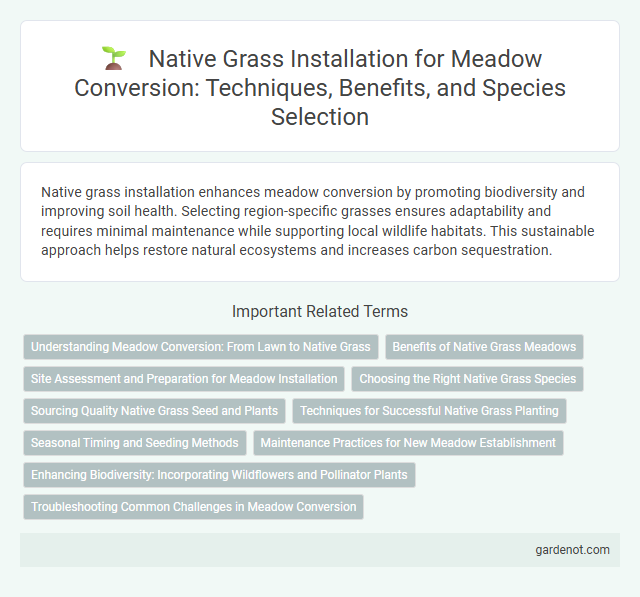Native grass installation enhances meadow conversion by promoting biodiversity and improving soil health. Selecting region-specific grasses ensures adaptability and requires minimal maintenance while supporting local wildlife habitats. This sustainable approach helps restore natural ecosystems and increases carbon sequestration.
Understanding Meadow Conversion: From Lawn to Native Grass
Meadow conversion transforms traditional lawns into vibrant native grass landscapes that support local ecosystems and require less water and maintenance. Installing native grasses enhances biodiversity by providing habitat for pollinators and wildlife while improving soil health through deep root systems. Proper selection and site preparation ensure successful establishment, maximizing environmental benefits and long-term sustainability.
Benefits of Native Grass Meadows
Native grass meadows enhance biodiversity by providing habitat for pollinators, birds, and beneficial insects, contributing to ecosystem resilience. These meadows improve soil health through deep root systems that increase water infiltration and reduce erosion, supporting sustainable land management. Additionally, native grasses require less irrigation and chemical inputs, leading to lower maintenance costs and a reduced environmental footprint.
Site Assessment and Preparation for Meadow Installation
Site assessment for native grass installation in meadow conversion involves analyzing soil quality, moisture levels, sunlight exposure, and existing vegetation to ensure optimal growth conditions. Proper site preparation includes removing invasive species, tilling the soil to enhance aeration, and amending with organic matter to promote nutrient availability. These steps are essential for establishing a resilient native grass meadow that supports biodiversity and ecosystem health.
Choosing the Right Native Grass Species
Selecting the right native grass species is crucial for successful meadow conversion, as it ensures adaptability to local soil, climate, and ecosystem conditions. Species such as Big Bluestem, Switchgrass, and Little Bluestem provide deep root systems that enhance soil health and support biodiversity. Prioritizing native grasses that are drought-tolerant and resistant to pests reduces maintenance needs and promotes long-term sustainability.
Sourcing Quality Native Grass Seed and Plants
Quality native grass seed and plants for meadow conversion are sourced from reputable local nurseries and certified seed suppliers to ensure ecological compatibility and genetic diversity. Selecting regionally adapted species improves survival rates and supports local wildlife by maintaining the native ecosystem balance. Using high-purity, weed-free seed batches minimizes invasive species introduction and promotes a sustainable, resilient meadow environment.
Techniques for Successful Native Grass Planting
Effective native grass installation relies on site preparation methods such as soil testing, tilling, and weed control to create optimal growing conditions. Selecting appropriate native species based on local climate and soil characteristics enhances establishment success and ecosystem compatibility. Proper seeding techniques, including seedbed firming and using a seed drill or broadcast seeding followed by light raking, improve seed-to-soil contact and germination rates.
Seasonal Timing and Seeding Methods
Native grass installation in meadow conversion requires precise seasonal timing, ideally during early spring or late fall, to align with natural growth cycles and maximize germination rates. Seeding methods such as drill seeding or hydroseeding ensure even distribution and soil contact, enhancing seed-to-soil interaction critical for native grass establishment. Optimal moisture levels during these periods support root development, while avoiding mid-summer heat stress that can inhibit seedling survival.
Maintenance Practices for New Meadow Establishment
Proper maintenance practices for new meadow establishment include regular mowing at a height of 4 to 6 inches to encourage healthy native grass growth and prevent invasive species. Implementing periodic weeding and monitoring soil moisture levels supports root development and overall plant vigor. Avoiding excessive fertilizer use preserves soil balance and promotes long-term sustainability of native grass meadows.
Enhancing Biodiversity: Incorporating Wildflowers and Pollinator Plants
Incorporating native wildflowers and pollinator plants during meadow conversion significantly enhances biodiversity by providing essential habitats and food sources for bees, butterflies, and other beneficial insects. This diverse plant palette supports a wide range of wildlife, promoting ecological balance and resilience within the meadow ecosystem. Establishing species like Echinacea, Black-eyed Susan, and milkweed ensures continuous bloom periods, improving pollinator attraction and habitat connectivity.
Troubleshooting Common Challenges in Meadow Conversion
Native grass installation during meadow conversion often faces challenges such as poor seed germination, soil compaction, and invasive weed competition. Addressing soil health through aeration and organic amendments promotes root establishment, while selecting appropriate native seed mixes tailored to local conditions enhances resilience. Regular monitoring and targeted spot treatments facilitate early detection and management of invasive species, ensuring successful meadow restoration.
Native grass installation Infographic

 gardenot.com
gardenot.com